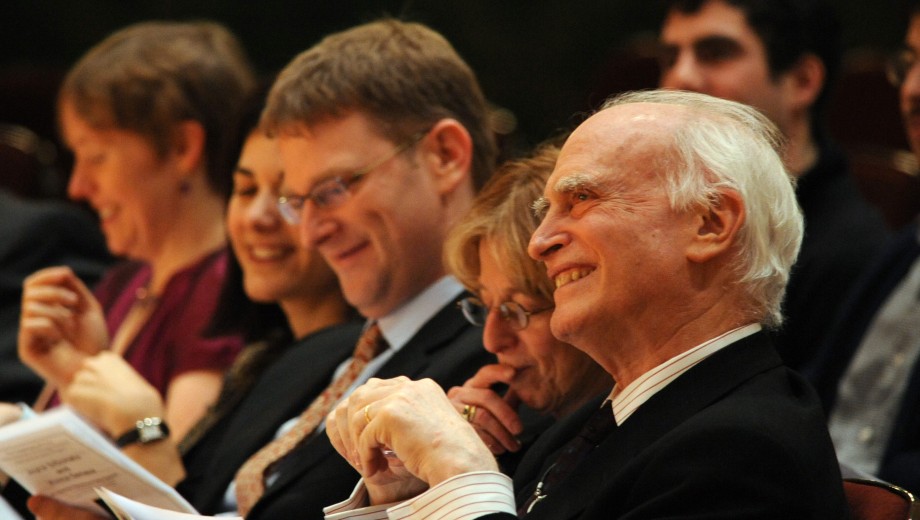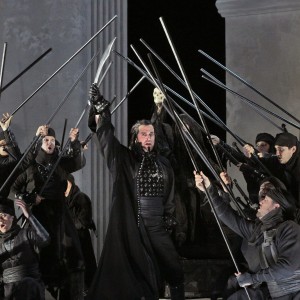Philip Gossett’s career is captured in the title of his 2006 book, the award-winning Divas and Scholars: Performing Italian Opera (University of Chicago Press). Since his graduate studies at Princeton in the 1960s, Gossett has focused on the recovery and careful study of musical sources of operas by nineteenth-century Italian composers, and on understanding how the works function as dramas and in performance. A prolific scholar and frequent collaborator with opera houses and performers, Gossett has developed close relationships with many leading conductors and singers—the “divas” to which the title of his book refers.
Gossett, the Robert W. Reneker Distinguished Service Professor Emeritus in Music, officially retired in 2010. He serves as the general editor of two critical editions, The Works of Giuseppe Verdi (Chicago/Casa Ricordi) and Works of Gioachino Rossini (Bärenreiter). He is also a sought-after consultant.
Among the highlights of the past year, Gossett cites his work at the New England Conservatory of Music in Boston, where he was awarded an honorary degree. Students there were working on the first-ever complete performance of a little-known Rossini comic opera, La gazzetta, written in 1816. When the critical edition of the opera was published in 2002, one of the pieces, a quintet, was thought to be lost forever. “We knew about it from the printed libretto for the original production, which has the text for the quartet,” says Gossett, “but no musical source seemed to exist for it.”
Two years ago Gossett identified the missing quintet in Palermo, Italy, enabling the New England Conservatory to perform Rossini’s work in its entirety for the first time ever. Gossett will also be involved in the first complete professional production of La gazzetta at the Opera Royal de Wallonie in Liège, Belgium, in June.
Rossini also figures in Gossett’s next collaboration with La Scala, which will produce Le Comte Ory, a French opera Rossini wrote in 1828, drawing on the forthcoming critical edition published in Works of Gioachino Rossini. “Le Comte Ory has been known throughout the world in a version by Troupenas, Rossini’s publisher in Paris,” says Gossett. Troupenas printed and disseminated a remarkably shorter version of the opera, trying to contain the work within the acceptable length for a so-called petit-opéra, a through-composed (that is, featuring uninterrupted music) opera without ballet.
Gossett oversaw the work of Damien Colas, the editor of the critical edition for Le Comte Ory. Basing his edition on material in the archives of the Paris Opéra, Colas tapped the performing materials used for the first production of the opera and reconstructed all the music Rossini prepared for it, including 66 additional measures for the finale, which, as Gossett has noted, more than doubles the length of the standard version. This summer Gossett will give a talk at La Scala on the opera and the critical edition. The director of La Scala’s July production, Laurent Pelly, “is absolutely convinced that this is the right version to do today,” says Gossett. Pelly also staged Le Comte Ory at the Lyon Opera House in March, insisting that both theaters adopt the edition.
Keeping Current
Gossett’s interests stretch to encompass more recent music. In 2012 he gave a talk at La Scala on Benjamin Britten’s Peter Grimes, a landmark twentieth-century opera. He also helped an Italian group, the Ensemble Nuove Musiche, develop its project Verdi nostro contemporaneo (Verdi, Our Contemporary), and organize its US tour, which included a 2013 concert at the Reva and David Logan Center for the Arts on campus. The group performed pieces by several contemporary composers based upon Verdi songs. Gossett is now working with the ensemble on a project inspired by Rossini’s many versions of “Mi lagnerò tacendo,” a series of songs from a poem by eighteenth-century poet Pietro Metastasio. “Rossini loved this text and used it again and again,” says Gossett, each time coming up with strikingly different musical solutions. The idea is that a group of contemporary composers, including Marta Ptaszynska, the Helen B. and Frank L. Sulzberger Professor in Music, will create new works starting from these materials.
Gossett has worked with prominent contemporary composers, including opera composer Azio Corghi, who collaborated with him on the critical edition of Rossini’s comic opera L’italiana in Algeri (The Italian Girl in Algiers). He has collaborated with veteran opera singers such as Marilyn Horne, Samuel Ramey, and Renée Fleming, and with newcomers like mezzo-soprano Isabel Leonard. As Leonard prepared to sing the lead female role in the 2014 production of The Barber of Seville at Chicago’s Lyric Opera, she and Gossett focused particularly on the embellishments and vocal ornamentation to be added to her part. Indeed, he says, the structure of Rossini’s music leaves room for the interpreter’s imagination; during Rossini’s era opera composers expected singers to add personal touches to their roles.
Gossett is a longtime admirer of Riccardo Muti, the current music director of the Chicago Symphony Orchestra. “He has done several performances based on our critical editions,” says Gossett, including concert performances of the complete version of Verdi’s Macbeth last fall in Chicago. Conducting Ernani (another Verdi work) in Rome, Muti proved to be one of the few artists to consider attentively the opera’s original conclusion. The wording Verdi had first chosen in a passage of this piece—“a much stronger condemnation of Heaven,” according to Gossett—was later watered down, and the “sanitized” version has been heard in performance ever since. Consulting The Works of Giuseppe Verdi, Gossett says, “Muti realized Verdi was right, and it was better with Verdi’s words.”
Critical Sources
Relationships with performers are not always so collegial, and Gossett has many stories to tell. He recalls, for instance, conductor Gianluigi Gelmetti’s stubbornness in refusing to perform appoggiaturas (unwritten grace notes that often inflect the conclusion of a musical sentence, especially in opera recitatives) if they are not notated in the musical text. Gossett argues that these notes could not be written down, in order to prevent harmonic clashes, but it was standard practice for singers to introduce them, and there is abundant evidence that composers expected them to be performed.
This question points to a larger set of issues about the relationship between musical texts (and in particular texts of Italian operas) and their realization in performance. “I realized soon in the game that it was one thing to produce a critical edition—that is a text that is as close as possible to what a composer actually wrote—but you can’t think that he expected singers to perform his work exactly as he wrote it,” Gossett says. Many operatic pieces—for instance, cabalettas, the final, fast-moving, and often virtuosic section of a piece—are conceived in a way that allows the singer to add his or her own ornamentation to the composer’s original melody. There are countless examples where Rossini suggested such ornaments for individual singers, and these suggestions were “determined by the capabilities of a particular person.”
Since these embellishments were meant to be tailored to each interpreter, a composer would never write them down in his autograph (the musical manuscript written in the author’s own hand). “Composers expected singers to be partners in the realization of a work,” explains Gossett. Scholars working on critical editions of Italian opera seek to understand what the composer wrote and intended, and to provide as much historical evidence as possible about the ways in which performers developed their own approach to the music.
Scholars may include evidence of what singers performed in the past as appendices to a critical edition, leaving present-day musicians to use these historical documents as they see fit. “When we published The Barber of Seville, for instance, we also published the actual ornamentation applied by several singers up to 1850,” says Gossett. This choice enables performers today either to resuscitate solutions originally conceived by singers who worked with the composer—or to use this body of materials to come up with new musical ideas that both match their own capability and are stylistically plausible.
New Projects
Over the years, Gossett has launched a constellation of side research projects to support his work on critical editions. One of the most recent is OperaCat, a database of autograph manuscript items related to the five major Italian composers of the nineteenth century (Rossini, Bellini, Donizetti, Verdi, and Puccini). Sold at auctions, the items now lie in private hands, but their existence can be traced through auction or antique catalogs. Because such catalogs often include reproductions of the items, OperaCat allows researchers to see which documents exist, and sometimes even their content. Directed by Daniela Macchione of Rome and carried out in collaboration with the Newberry Library, the project currently consists of more than 6,000 entries and has benefitted from the work of several of Gossett’s former and current students.
Gossett remains active as a teacher and as a dissertation adviser. In fall 2012 he offered a graduate seminar on Rossini’s vocal music, focusing on the pieces he was preparing for Works of Gioachino Rossini. He currently advises three doctoral students. One is writing a dissertation about how Italian opera contributed to the creation and consolidation of cultural networks between Italy and Vienna in the first half of the nineteenth century, and the political tensions and fallout resulting from this transnational circulation of people and scores across the Alps. Another is studying the interaction between foreign and Russian composers in St. Petersburg in the early nineteenth century.
Many of Gossett’s current and former students have also worked with faculty members outside the Department of Music. While writing his dissertation on sentimental opera in the eighteenth century, for instance, Stefano Castelvecchi, AM’92, PhD’96, collaborated with scholars in Romance Languages, English, and History. Part of the draw of UChicago, says Gossett, is that it offers European students the opportunity to approach the study of opera from cultural and theoretical perspectives different from those available in Europe. Students also develop teaching skills, which is less of a priority of European academic programs.
Gossett is no less busy than before he retired. Wrapping up an interview, he is already making plans for his next flight to Italy. “Philip in ‘retirement’?” wonders an amused Elizabeth Parker, coordinator of the University’s Center for Italian Opera Studies and Gossett’s close collaborator. “I think he can spell the word, but he doesn’t know what it means.”
PHOTOGRAPHY BY DAN DRY


